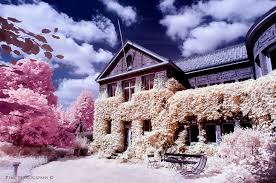The Magic of Infrared Photography
Infrared photography is a fascinating technique that captures light not visible to the human eye. By using infrared-sensitive film or digital sensors, photographers can create surreal and dreamlike images that showcase a different perspective of the world around us.
Unlike traditional photography that relies on visible light, infrared photography detects wavelengths beyond what our eyes can see. This results in striking images where foliage appears bright white, skies turn dark and dramatic, and landscapes take on an otherworldly quality.
One of the most captivating aspects of infrared photography is its ability to transform familiar scenes into something unexpected and ethereal. Everyday objects and landscapes are rendered in a unique way, inviting viewers to see the world through a new lens.
Photographers who delve into infrared photography often experiment with different techniques to achieve desired effects. From using special filters to post-processing methods, there are endless possibilities for creative expression in this genre.
Whether capturing mystical landscapes, haunting portraits, or abstract compositions, infrared photography offers a wealth of artistic opportunities for those willing to explore its magic.
So next time you pick up your camera, consider venturing into the enchanting realm of infrared photography. Discover the hidden beauty that lies beyond the visible spectrum and unlock a world of creativity waiting to be explored.
Essential FAQs for Mastering Infrared Photography Techniques and Equipment
- What is infrared photography and how does it work?
- What equipment do I need to start with infrared photography?
- How do I convert my camera for infrared photography?
- What are the best settings for capturing infrared images?
- Can I create black and white images with infrared photography?
- Are there any post-processing tips specific to enhancing infrared photos?
What is infrared photography and how does it work?
Infrared photography is a captivating technique that involves capturing light beyond the visible spectrum to create unique and surreal images. Unlike traditional photography that relies on visible light, infrared photography uses infrared-sensitive film or digital sensors to detect wavelengths that are invisible to the human eye. This results in photographs where colours appear differently, with foliage often appearing as bright white and skies taking on a dramatic tone. By understanding how to manipulate infrared light and experimenting with different equipment and techniques, photographers can unlock a world of creative possibilities and produce captivating images that offer a fresh perspective on the world around us.
What equipment do I need to start with infrared photography?
To embark on your journey into infrared photography, you will need specific equipment to capture the unique light wavelengths involved. Key essentials include an infrared-sensitive camera or a regular camera converted for infrared photography, infrared filters to block visible light and allow only infrared light to pass through, and a sturdy tripod to ensure sharp and stable shots due to longer exposure times. Additionally, consider investing in post-processing software to fine-tune your infrared images and bring out their distinctive characteristics. By assembling the right tools, you can unlock the captivating world of infrared photography and unleash your creativity in capturing unseen beauty.
How do I convert my camera for infrared photography?
Converting your camera for infrared photography involves removing the internal infrared-blocking filter and replacing it with a filter that allows infrared light to pass through. This modification is typically done by professional camera technicians who specialise in infrared conversions. By making this adjustment, your camera becomes sensitive to infrared light, enabling you to capture stunning infrared images with unique colours and effects. It’s essential to consult with experts in the field to ensure that the conversion process is carried out correctly, allowing you to explore the captivating world of infrared photography with confidence and creativity.
What are the best settings for capturing infrared images?
When it comes to capturing stunning infrared images, setting the right parameters on your camera is crucial. For optimal results in infrared photography, photographers often recommend using a low ISO setting to reduce noise, a small aperture for increased depth of field, and a slower shutter speed to allow more light to reach the sensor. Additionally, adjusting the white balance to compensate for the infrared light spectrum can help achieve accurate colours in the final image. Experimenting with different settings and fine-tuning them based on lighting conditions and desired effects can lead to captivating infrared photographs that truly stand out.
Can I create black and white images with infrared photography?
Infrared photography offers a unique approach to creating black and white images, as the technique captures light beyond the visible spectrum. By using infrared-sensitive film or digital sensors, photographers can achieve striking monochromatic images with a distinct tonal range and ethereal quality. The inherent contrast between infrared light and dark shadows lends itself well to black and white compositions, allowing for the creation of dramatic and atmospheric photographs that evoke a sense of mystery and intrigue. Experimenting with infrared photography can open up new possibilities for capturing stunning black and white imagery that transcends traditional visual boundaries.
Are there any post-processing tips specific to enhancing infrared photos?
When it comes to enhancing infrared photos through post-processing, there are several tips that can help bring out the unique qualities of these images. One key technique is adjusting the white balance to achieve the desired tonal range, as infrared photos often have a reddish or pinkish hue straight out of the camera. Experimenting with contrast and clarity can also enhance the ethereal quality of infrared images, bringing out details in both highlights and shadows. Additionally, playing with colour channels can create striking effects, such as swapping red and blue channels to achieve a surreal blue sky against white foliage. By fine-tuning these post-processing techniques, photographers can elevate their infrared photos to new levels of visual impact and creativity.

